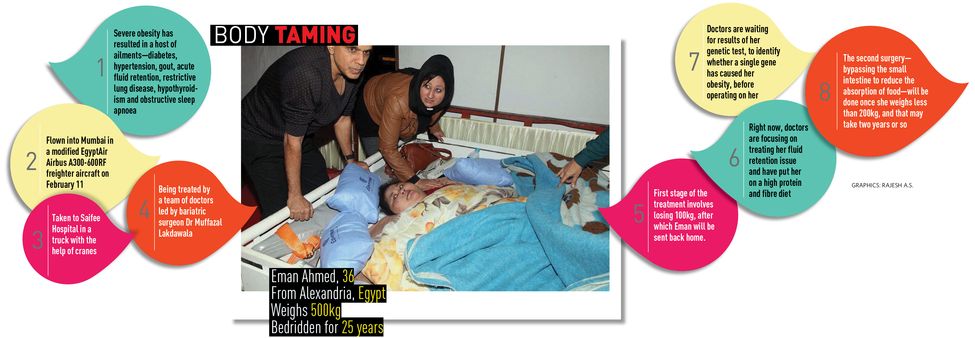At 500kg, Egyptian national Eman Ahmed Abd El Aty, 36, is believed to be the heaviest woman in the world. For 25 years, she was bedridden, spending most of her time staring at the ceiling, watching television and talking to loved ones. In February, she left the confines of her home in Alexandria and flew to Mumbai for treatment at Saifee Hospital. According to doctors, Eman suffers from a host of ailments—diabetes, hypertension, gout, acute fluid retention, restrictive lung disease, hypothyroidism and obstructive sleep apnoea—owing to severe obesity. She is also at a high risk of pulmonary embolism. As of now, her Body Mass Index (BMI) is 252 while a normal individual’s is 24.
Eman started gaining weight drastically at the age of 11. As her legs could not support her weight, she would initially crawl. She was body-shamed and bullied in school, and she dropped out when she was in class five. Two years ago, she suffered a stroke. All these years, she was taken care of by her mother, a tailor, and younger sister, Shaimaa. Her father, an architect, died seven months ago. Shaimaa quit her engineering job to take care of Eman, from feeding and bathing her to helping her answer nature’s call. “For my mother and I, Eman is like a baby. We do everything for her and when she wasn’t able to speak after suffering a stroke two years ago, we would communicate with her in sign language,” says Shaimaa, who left her two-year-old daughter with her mother to accompany Eman to India.
As Eman’s condition kept getting worse, Shaimaa started looking for doctors and also started a social media campaign for her sister’s treatment. A few months later, a friend introduced her to Dr Muffazal Lakdawala, chairman of the Institute of Minimal Invasive Surgical Sciences and Research Center at Saifee Hospital, and she wrote to him. “In her letter, she asked me to help her. At that point, I didn’t know if it would be possible, but I still agreed,” says Lakdawala. “They didn’t know that it was Eman’s severe obesity that was causing the complications. Shaimaa believed she was suffering from elephantiasis, a condition where the patient’s limbs or other body parts swell due to an infection.”
But Eman’s journey to India for the bariatric surgery was fraught with obstacles. Her visa application was rejected as she was unable to visit the Indian embassy. However, Lakdawala tweeted to External Affairs Minister Sushma Swaraj, and she helped expedite the process. The next challenge was to find a flight that could carry her. Through a crowdfunding initiative, Lakdwala raised 083 lakh for her flight to Mumbai, and an EgyptAir Airbus A300-600RF freighter aircraft was modified, taking her weight and girth (151cm) into consideration. After a six-hour flight, Eman, Shaimaa, a team of doctors and medical equipment that weighed 300kg, landed safely in Mumbai on February 11 at 4am. She was brought to Saifee Hospital in a truck; her specially designed bed was loaded onto the truck using cranes.
 Size woes: Eman with sister, Shaimaa, and Dr Lakdawala | PTI
Size woes: Eman with sister, Shaimaa, and Dr Lakdawala | PTI
The hospital, which is treating Eman pro bono, built a 1,000sq ft room for her on the first floor, which has a patient’s room, scrub room, attendant’s room and toilet. With an all-women team of nurses looking after her, she has been put on a liquid protein-rich diet along with fibre and dairy supplements. Doctors say her skin has become as hard as rock owing to fluid retention, and they have started physiotherapy to reduce the accumulated fluid in her body.
The first stage of Eman’s treatment, say doctors, involves making her lose 100kg and help her sit up and have food without anyone’s assistance, after which she will be sent back home. The doctors, however, haven’t taken a call on when to operate as they are waiting for the results of her genetic test. “There are several genes that have been implicated with obesity,” says Dr Shehla Shaikh, consultant endocrinologist at the hospital. “If the genetic test reveals that she has monogenic obesity—a single gene that is causing these issues—then we might concentrate more on medical management to control her obesity.”
Once doctors manage to bring down her weight below 200kg, they will go ahead with the second bariatric surgery. “In the second surgery, which might take place only after two years or so,” says Lakdawala, “we plan to bypass the small intestine so that the absorption of food is reduced to only 20-25 per cent. This is because she has extremely low metabolism.”
Lakdawala is all praise for Shaimaa and her mother for the way they took care of Eman. “The perseverance of the mother and daughter in taking care of Eman is phenomenal. On a daily basis, both of them would manage to clean her by pushing her to one side and repeating the process with relative ease,” he says. “On the other hand, six doctors were trying to move Eman after she was moved to her room and they were initially unable to. Eman burst out laughing and said that back home her mother and sister were able to manage everything on their own. This is a strong case of women power as she hasn’t had a single bedsore in the last 25 years. The reason why Eman was able to travel all the way to India is because Shaimaa never lost hope.”






